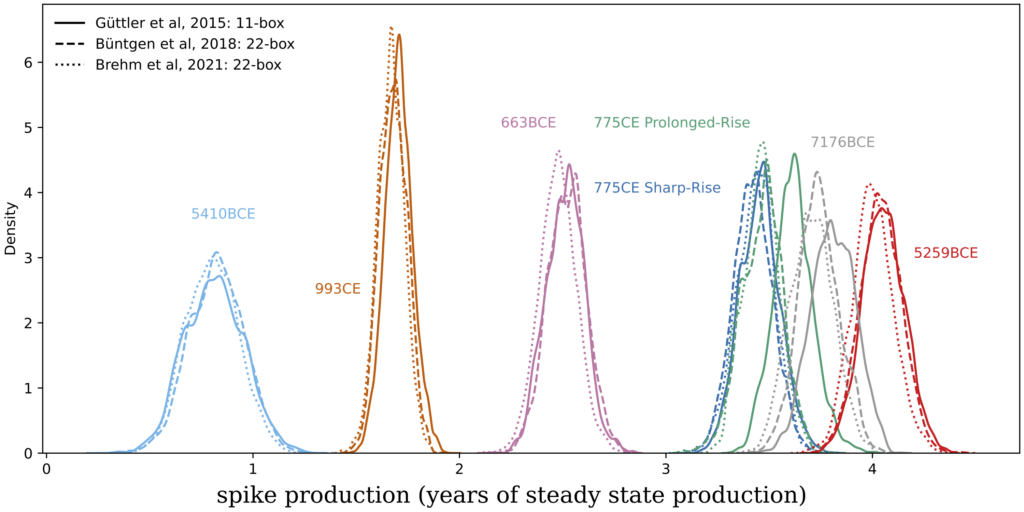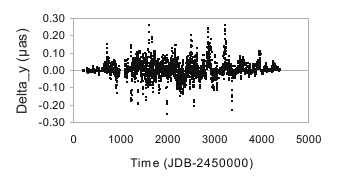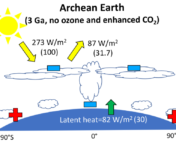Title: Modelling Cosmic Radiation Events in the Tree-ring Radiocarbon Record
Authors: Qingyuan Zhang, Utkarsh Sharma, Jordan A. Dennis, Andrea Scifo, Margot Kuitems, Ulf Büntgen, Mathew J. Owens, Michael W. Dee, and Benjamin J. S. Pope
First Author Institution: School of Mathematics and Physics, University of Queensland, St Lucia, QLD 4072, Australia
Status: Accepted in Proceedings of the Royal Society, available on arxiv
Breathe in
You are a tree. Your trunk, strong and true, reaches to the dark night sky. A gust rustles through your branches. Your leaves taste the distant starlight like snowflakes on a tongue, an aurora like a scent on the breeze. You stand among your peers, who you’ve seen grow alongside you, and who you know and interact with through your roots beneath the soil. Slowly but surely the dawn breaks, and your leaves start the day. They draw in carbon dioxide from the air and with the nourishing sunlight convert it to sugars helping you grow and survive. Something is different. You send down a biochemical question into the roots for the other trees – ‘Does the air taste a little heavier?’
Cut back to the present (and to a human body!) as we see if modern analysis of historical tree rings can trace changes of carbon in the atmosphere, potentially caused by astronomical events!
Science grows on trees
Carbon typically likes to be Carbon 12 (12C), but there is a small amount of Carbon 14 (14C) that is introduced to the Earth. 14C decays at some well characterized rate, (this is the process behind carbon dating) but is replenished in our atmosphere thanks to interactions with cosmic rays. This new 14C then enters into the carbon cycle, a system that describes how carbon on our planet shuffles back and forth between different carbon “reservoirs”, including the atmosphere, the oceans, and life on the planet.

A very successful way for biotic life to become a carbon of reservoir is for a tree to make tree rings. Trees add to their bark in annual growth spurts, which then become the foundation for the next year’s growth, essentially locking in a description of the carbon cycle for that year within its trunk. Even if the tree dies, the record of how much 14C the tree absorbed remains neatly packaged into yearly increment, which also allows us to date each ring. So all things being equal, 14C is made at some regular rate in the atmosphere, gets moved about in the carbon cycle where it will at some decay.
But what about when things aren’t equal? We have evidence of Miyake events, times in the last ten thousand years where trees, on different sides of the globe, suddenly used more 14C to grow! The main way to introduce more 14C is through interaction in the upper atmosphere, so perhaps a solar flare caused an influx of cosmic rays? Today’s authors used models of the Carbon cycle to analyze the 14C tree ring data to see if they could associate these upticks in 14C to astrophysical phenomena interacting with the atmosphere, for example the solar activity cycle.
What’s in the box?
The authors picked 4 slightly different kinds of models for the carbon cycle from the literature, known as box models, with each “box” being a simplified version of carbon reservoirs. While the box models used were simplified, the analysis used was involved; bayesian inference and MCMC. These tools are great for asking the question, “given our limited observations for each of the 6 Miyake events seen in the tree rings, what are the range of possible 14C production rates that could explain it?” Bayesian methods don’t always give you an exact answer, but in this case they represent a probability of possible 14C rates based on the Miyake events’ data.
Even after they modeled the Miyake events, their durations were challenging to constrain (Figure 1). Since the rings form yearly, the time resolution is on the same scale. While they were able to show that three of the events were consistent with ~1 year timescales, some show durations of the 14C changes steadily increasing on greater than a year timescales. In these cases the event is less likely to be a single solar flare.

They also show that the Miyake events were big moments of 14C production (Figure 2)! Each event likely introduced 1-4 times more 14C than the baseline annual rates. While only a few of the events lined up with likely solar activity, it’s clear that something interacted with the atmosphere to produce more 14C. While the chances of a solar flare hitting the earth peak during the maximum activity in the solar cycle, there still could be a chance of a large event outside of the cycle, or even some other source of interaction. A recent extremely powerful gamma ray burst was shown to affect the ionosphere, who knows what other astrophysical sources might chance to interact with Earth’s atmosphere!
Breathe out
The strongest solar flare that has ever been measured by modern astronomers is a fraction of what would be needed to cause a Miyake event. There is a historical record of an aurora that might link a solar flare to the 775CE event. The earliest human cave paintings are still fresh during the oldest identified Miyake event, but there is no reason to think that 10,000 years ago is the oldest. The time trees have spent on the planet is thousands of times longer than that, and have always been interacting with the carbon cycle. It’s nice to know that the silent sentinels of our planet witnessed the universe in their own way. What cosmic glories might they have transcribed within themselves?
Featured Image by Vincent Guth on Unsplash
Astrobite edited by Lili Alderson





C14 does not decay to C12, but N14.
Good point, the article has been updated.
As a biophysicist, my understanding of beta decay is that a neutron becomes a proton. Therefore carbon 14 becomes nitrogen 14 and not carbon 12 as stated in the article. A down quark flips becoming an up quark.
Good point, the article has been updated.